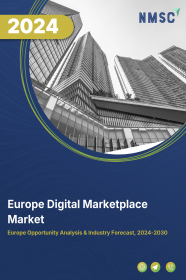
Europe Digital Marketplace Market by Product/Service Type (Physical Goods, Digital Goods, Services, and Event & Ticket Sales), by Platform (Desktop, Mobile, and Tablets), by Model Type (Business to Business (B2B), Business to Consumer (B2C), and Consumer to Consumer (C2C)), and by End Users (Commercial, and Personal) - Opportunity Analysis and Industry Forecast, 2024 – 2030
Industry: ICT & Media | Publish Date: 04-Oct-2025 | No of Pages: 272 | No. of Tables: 201 | No. of Figures: 126 | Format: PDF | Report Code : IC2235
Europe Digital Marketplace Market Overview
The Europe Digital Marketplace Market size was valued at USD 96.87 billion in 2023, and is predicted to reach USD 163.67 billion by 2030, at a CAGR of 7.7% from 2024 to 2030. Digital marketplace market, also referred to as online marketplaces or digital commerce platforms, serve as virtual centers where individuals seeking to buy or sell goods, services, or information convene to conduct transactions. Operating as intermediaries, these platforms facilitate exchanges among various parties, such as buyers and sellers, within a centralized online environment tailored for effortless product discovery, purchasing, and delivery. Well-known examples of online marketplaces include prominent e-commerce platforms such as Amazon, eBay, and Alibaba, alongside service-oriented platforms such as Upwork and Fiverr.
Harnessing technology, these platforms streamline transaction processes, ensuring efficient and secure payment processing while safeguarding the financial information of all participants. Furthermore, they enrich user experiences by providing features such as customer reviews, ratings, and mechanisms for addressing transaction-related issues. Consequently, online marketplaces leverage technology to improve the overall online commerce experience, simplifying and securing transactions for both buyers and sellers. They play a vital role in today's economy by bridging the gap between businesses and consumers across geographical boundaries, thereby facilitating smooth and convenient global commerce.
Advancements In Digital Payments And Fintech Solutions
The rapid evolution of Europe’s digital payment ecosystem is a key driver of marketplace growth. Consumers increasingly expect seamless, secure, and localized payment options, ranging from digital wallets and contactless cards to Buy Now Pay Later (BNPL) services and instant SEPA transfers. Fintech players such as Klarna, Adyen, and Revolut have become integral to enhancing consumer trust and convenience, especially for cross-border transactions. These solutions not only reduce friction at checkout but also improve conversion rates for marketplace operators. Moreover, regulatory support such as the EU’s PSD2 directive has further strengthened security and interoperability across payment systems, encouraging wider adoption of online platforms.
Growing Emphasis On Sustainability And Circular Economy Models
Environmental awareness and responsible consumption are increasingly shaping consumer choices across Europe, prompting digital marketplaces to adapt to these expectations. Platforms specializing in second-hand goods, refurbished electronics, and eco-friendly products—such as Vinted, Back Market, and Vestiaire Collective—are experiencing accelerated adoption. This movement is reinforced by EU-level initiatives promoting the circular economy and sustainable consumption practices, which encourage both businesses and consumers to shift toward greener models. Marketplaces that implement transparent sourcing, carbon-neutral delivery, and recycling programs are strengthening their competitive edge, as European buyers show a clear preference for platforms aligned with social and environmental responsibility.
Fragmented Regulatory Environment Across Non-EU Markets
Europe’s digital marketplace landscape benefits from EU-level harmonization, yet platforms operating in non-EU countries such as the UK, Switzerland, and Norway continue to face regulatory complexity. Differing frameworks for data protection, consumer rights, customs duties, and tax regimes present operational challenges that can slow growth. In particular, post-Brexit regulatory divergence has created additional compliance burdens for sellers targeting UK consumers. This fragmented environment increases costs, lengthens expansion timelines, and complicates logistics, ultimately limiting the scalability of cross-border digital marketplaces across the broader European region.
Emerging Vertical and Niche Marketplaces
Europe is witnessing strong momentum in specialized and sustainability-driven marketplaces, reflecting changing consumer preferences. Platforms focusing on second-hand fashion (Vinted, Vestiaire Collective), home improvement (ManoMano), refurbished electronics (Back Market), and organic/eco-friendly products are rapidly scaling. These niche players differentiate themselves through curated product selections, strong community engagement, and alignment with Europe’s growing sustainability agenda. With increasing consumer focus on ethical sourcing, circular economy models, and localized shopping experiences, vertical marketplaces hold significant long-term growth potential across the region.
UK Dominates the Europe Digital Marketplace Market Share
The UK's dominance in the digital marketplaces market is fueled by the widespread ownership of smartphones in the region. According to data from the Pew Research Center in February 2024, 86% of the UK population possesses a smartphone. With a large segment of the population embracing smartphones, access to digital platforms becomes more widespread among consumers.
As smartphone ownership continues to rise, digital commerce platforms in the UK expand their reach and influence, offering increased convenience and opportunities for businesses and consumers alike. Moreover, in the UK, the "E-Commerce Week" campaign was launched in February 2024 to encourage 70,000 small businesses to venture into international sales through e-commerce platforms.
This initiative is supported by the UK’s E-Commerce Trade Commission, established by the Institute of Export & International Trade (IOE&IT) in June 2023. With backing from the UK’s E-Commerce Trade Commission, businesses are motivated to enhance their online presence, resulting in a surge of listings and transactions on digital marketplaces. This concerted effort is poised to significantly propel the online marketplaces market in the region.
Spain to Witness Substantial Growth in the Europe Digital Marketplace Market Trends
Spain is positioned for significant growth in the market that is attributed to the expansion of the e-commerce sector in the region, rising shifts in both consumer behavior and business strategies. According to the International Trade Administration, the number of e-commerce users in Spain is projected to increase by 25% to 37 million by 2025.
With the rise in internet penetration and the widespread adoption of smartphones, more Spaniards are opting for online platforms for their shopping requirements. This surge in e-commerce activity propelled the expansion of online marketplaces, offering a convenient and accessible avenue for both consumers and businesses to engage in buying and selling goods and services.
Moreover, the COVID-19 pandemic further accelerated this trend, as lockdown measures prompted a surge in online shopping and increased demand for online marketplaces platforms. Consequently, the digital marketplace market in Spain witnessed robust growth, with platforms such as Amazon, eBay, and local marketplaces experiencing heightened user engagement and transaction volumes. This growth trajectory is anticipated to persist as e-commerce continues to evolve and innovate, driving further expansion and opportunities in the Spanish online marketplace landscape.
Competitive Landscape
The key players operating in the Europe digital marketplace industry include Amazon.com, Inc., EBay, Zalando, Allegro, Vinted, Temu, SHEIN EUR, Otto Group, Etsy Inc., Bol.com, Kaufland, ASOS, , Fnac, , Cdiscount, EMAG, Worten, Kleinanzeigen, Next Retail Ltd, Alibaba.com, Rakuten and others.
Europe Digital Marketplace Market Key Segments
By Product/Service Type
-
Physical Goods
-
Electronics
-
Clothing
-
Food
-
Furniture
-
Handbag & Accessories
- Jewelery
-
Others
-
-
Digital Goods
-
Software
-
E-Books
-
Music & Videos
-
Games
-
-
Services
-
Freelancing
-
Education
-
Consultations
-
Others
-
-
Event & Ticket Sales
By Platform
-
Desktop
-
Mobile
-
Tablets
By Model Type
-
Business to Business (B2B)
-
Business to Consumer (B2C)
-
Consumer to Consumer (C2C)
By End-User
-
Commercial
-
Personal
By Country
-
Europe
-
U.K.
-
Germany
-
France
-
Italy
-
Spain
-
Denmark
-
Netherlands
-
Finland
-
Sweden
-
Norway
-
Russia
-
Rest of Europe
-
Key Players
-
Amazon.com, Inc.
-
EBay
-
Zalando
-
Allegro
-
Vinted
-
Temu
-
SHEIN EUR
-
Otto Group
-
Etsy Inc.
-
Bol.com
-
Kaufland
-
ASOS
-
Fnac
-
Cdiscount
-
EMAG
-
Worten
-
Kleinanzeigen
-
Next Retail Ltd
-
Alibaba.com
-
Rakuten
REPORT SCOPE AND SEGMENTATION:
|
Parameters |
Details |
|
Market Size in 2023 |
USD 96.87 Billion |
|
Revenue Forecast in 2030 |
USD 163.67 Billion |
|
Growth Rate |
CAGR of 7.7% from 2024 to 2030 |
|
Analysis Period |
2023–2030 |
|
Base Year Considered |
2023 |
|
Forecast Period |
2024–2030 |
|
Market Size Estimation |
Billion (USD) |
|
Growth Factors |
|
|
Countries Covered |
12 |
|
Companies Profiled |
20 |
|
Market Share |
Available for 10 companies |
|
Customization Scope |
Free customization (equivalent up to 80 working hours of analysts) after purchase. Addition or alteration to country, regional, and segment scope. |
|
Pricing and Purchase Options |
Avail customized purchase options to meet your exact research needs. |

















 Speak to Our Analyst
Speak to Our Analyst
























